
Diagonal Time Spread
By:TradeWins Publishing Editors
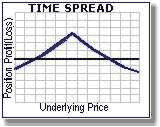
A systematic approach of trading volatility disparities.
Diagonal Time Spreads: A Quick Introduction
- A Diagonal Time Spread using Call Options: A trader sells an at the money or out
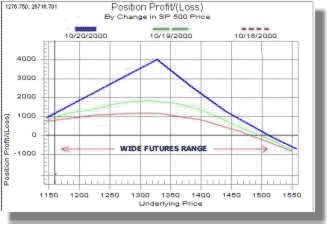 of the money call that expires in no less than 21 days and purchases a call with a different strike price in a deferred month. If the purchased call has a lower strike, it's closer to the money (or in the money) and the spread has a bullish bias. If the purchased call has a higher strike price, it's further out of the money and the spread has a bearish bias.
of the money call that expires in no less than 21 days and purchases a call with a different strike price in a deferred month. If the purchased call has a lower strike, it's closer to the money (or in the money) and the spread has a bullish bias. If the purchased call has a higher strike price, it's further out of the money and the spread has a bearish bias. - A Diagonal Time Spread using Put Options: A trader sells an at the money or out of the money put that expires in no less than 21 days and purchases a put with a different strike price in a deferred month. If the purchased put has a higher strike, it's closer to the money (or in the money) and the spread has a bearish bias. If the purchased put has a lower strike price, it's further out of the money and the spread has a bullish bias.
- Trader then waits. The Diagonal Time Spread can earn a profit over a wide range of prices provided the underlying futures contract doesn't move contrary to the delta bias and provided implied volatility doesn't collapse. The potential profit comes from positive time decay.
- Potential losses are limited because the long option partially hedges the short option. Potential profits are also limited and come at expiration date of the short option if the underlying futures are near the strike price of the short option.
- The Diagonal Time Spread can be adjusted to accommodate a swiftly trending market. The trader can "roll" the short option or the long option (or both) in the direction the underlying futures contract moves.
Diagonal Time Spreads: A Detailed Explanation
What is a "time spread"? You create a time spread (also known as a calendar spread) when you sell a call and hedge it by buying a call in a deferred month. You also create a time spread when you sell a put and hedge it by buying a put in a deferred month.
The time spread becomes a "diagonal" time spread if the short option has a different strike price than the long option. It will be bullish, bearish or neutral depending on the strike prices you choose.
Diagonal time spreads are popular because they:
- Earn positive time decay
- Earn profits over a wide range of underlying futures prices
- Can be tailored to fit a bullish, bearish or neutral outlook
- Limit your risk
- Can be modified as circumstances change
Note: Time spreads benefit when implied volatility rises, so they are appropriate to establish when implied volatility is low from a historical perspective or when implied volatility in the near month is higher than implied volatility in the deferred month.
When should a time spread be established? When implied volatility of the options in the near month is higher than the implied volatility of the options in the deferred month. When you expect a non-volatile, non-trending market. When you expect an environment of rising implied volatility.
What causes a timespread to lose? A collapse of implied volatility or a rapidly trending market can potentially cause a loss to this position.
How will a time spread perform? The performance graph of a time spread at expiration date of the short option takes on the appearance of a tent. Prior to expiration it has the appearance of a gently sloping hill. Holding time spreads within the last 3 weeks prior to expiration is risky since a move in the market can cause the short option to lose more than the profit on the long option. In graphic terms, the curvature of the performance graph (its gamma) is greater as you get closer to expiration.
What is its maximum profit or loss? Time spreads possess both limited profit and limited loss. Maximum profit is earned if the futures contract in the near month winds up on expiration day at the strike price of the short option.
Four Diagonal Time Spread Examples in the Crude Oil Market
Example #1 is a neutral to slightly bullish diagonal calendar spread. Example #2 is neutral to slightly bearish. Example #3 is more bullish than #1 while Example #4 is more bearish than #2.
Margin required in all cases ranges from $1,050 to $1,480.
Diagonal Time Spread Example #1 (neutral to slightly bullish) |
Market: Crude Oil |
Futures Price: |
Position: |
How to Put On the Position: |
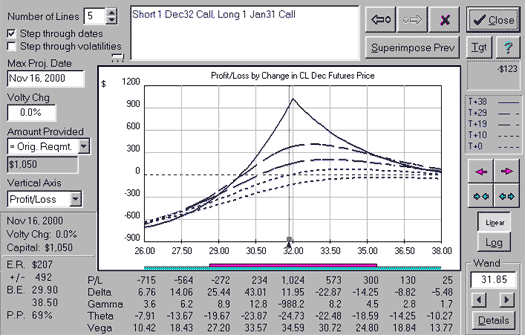
Key Parameters:
Margin = $ 1,050
Delta = +7, Gamma = -2, Vega = +$11, Theta = +$7
Strategy Description:
This is a diagonal call calendar spread using December and January calls. There are futures contracts for each month in Crude Oil, so the Dec and Jan calls relate to their respective underlying contracts.
The position is structured slightly delta long (+7), earns profits if CL remains unchanged or moves higher (probability of profit is 69%), benefits if implied volatility increases, and earns positive time decay. Each point in CL is worth $10.
The short Dec 32 call decays more rapidly than the long Jan 31 call because it's closer to expiring and further out of the money. That's the reason the spread earns $7 per day in positive time decay starting out.
In 38 days when the Dec options expire (Nov.16th) the spread can earn profits as long as the Dec CL futures contract (currently at 3185) winds up between 2990 and 3850 and as long as the relationship between Dec and Jan futures remains the same.
Why expect steady to higher oil prices? We're in the midst of a technically strong market, demand for Crude outstrips supply (the government just released 30 million barrels from the Strategic Petroleum Reserve), we're entering the Winter season, refineries are operating at peak capacity, and OPEC can acquiesce or "play hard ball."
Trading Plan:
Close the spread if profits reach $400 or if losses reach $300.
If neither occurs by expiration date (Nov. 16th), buy the Dec 32 call (to close) and sell a Jan CL 32 call. The position then becomes a Jan bull call spread.
Diagonal Time Spread Example #2 (neutral to slightly bearish) |
Market: Crude Oil |
Futures Price: |
Position: |
How to Put On the Position: |
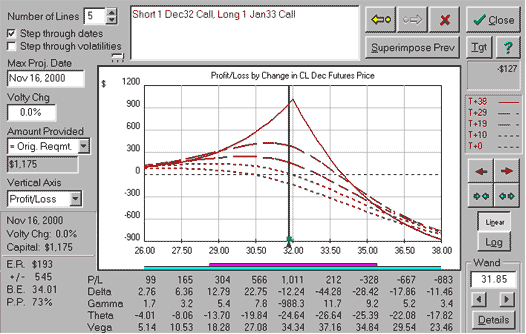
Key Parameters:
Margin = $ 1,175
Delta = -10, Gamma = -2, Vega = +$12, Theta = +$7
Strategy Description:
This is a diagonal call calendar spread that sells the at the money Dec call and buys the Jan call that's 100 points further out of the money. That's what makes this position slightly bearish.
This position earns profits if CL remains unchanged or declines. Clearly it's appropriate for traders with a different outlook than those who favor Position #1.
Trading Plan:
Close the spread if profits reach $400 or if losses reach $300.
If neither occurs by expiration date (Nov. 16th), buy the Dec 32 call (to close) and sell a Jan CL 32 call. The position then becomes a Jan bear call spread.
Diagonal Time Spread Example #3 (more bullish than #1) |
Market: Crude Oil |
Futures Price: |
Position: |
How to Put On the Position: |
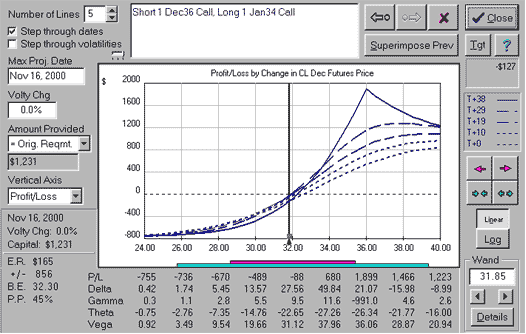
Key Parameters:
Margin = $ 1,231
Delta = +15 Gamma = +2 Vega = +$21 Theta = +$2
Strategy Description:
This is another variation on a diagonal call calendar spread using December and January calls. This position sells an out of the money Dec call and buys a closer to the money Jan call. That's why it's delta long (+15).
In 38 days when the Dec options expire (Nov.16th) the spread can earn profits as long as the Dec CL futures contract (currently at 3185) winds up above 3230 and as long as the relationship between Dec and Jan futures remains the same.
You can think of this spread like a bull call spread (except the options are in different months). So if the market rallies even a little it can earn a relatively large amount of money.
Trading Plan:
Close the spread if profits reach $1,000 or if losses reach $400.
If neither occurs by expiration date (Nov. 16th), buy the Dec 36 call (to close) and sell a Jan CL 35 call. The position then becomes a Jan bull call spread.
Diagonal Time Spread Example #4 (more bearish than #2) |
Market: Crude Oil |
Futures Price: |
Position: |
How to Put On the Position: |
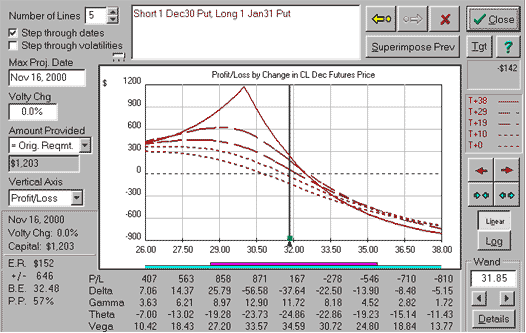
Key Parameters:
Margin = $ 1,203
Delta = -13 Gamma = -0.1 Vega = +$16 Theta = +$5
Strategy Description:
This is yet another variation on a diagonal calendar spread using December and January puts. This position sells an out of the money Dec put and buys a closer to the money Jan put. That's why it's delta short (-13). It's more aggressive than Position #2 for bearish traders.
In 38 days when the Dec options expire (Nov.16th) the spread can earn profits as long as the Dec CL futures contract (currently at 3185) finishes below 3248 and as long as the relationship between Dec and Jan futures remains the same.
You can think of this spread like a bear put spread (except the options are in different months). If the market declines even a little it can earn a relatively large amount of money. The breakeven point is even 63 points above the current price of Dec CL.
Trading Plan:
Close the spread if profits reach $800 or if losses reach $300.
If neither occurs by expiration date (Nov. 16th), buy the Dec 30 put (to close) and sell a Jan CL 30 put. The position then becomes a Jan bear put spread.
A Diagonal Time Spread Example in the S&P 500
Here's the evolution of a diagonal time spread in the S&P 500 market over the volatile period October 4, 2000 - October 17, 2000. It illustrates how adjustments can be made in response to market moves:
The daily chart below of the SP 500 futures market shows the downtrend during the time of this trade.
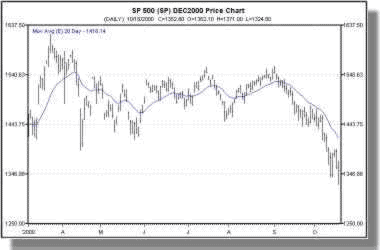
Oct 4
Sold 1 Oct SP 1450 call @ 2100 (to open)
Bought 1 Nov SP 1455 call @ 3350 (to open)
Oct 6
Bought 1 Oct SP 1450 call @ 1050 (to close for 1050 point profit)
Sold 1 Oct SP 1425 call @ 2250 (to open)
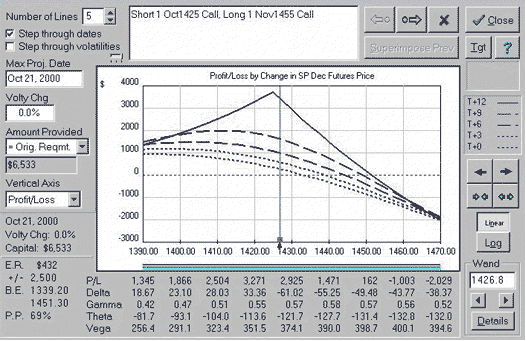
Oct 9
Sold 1 Nov SP 1455 call @ 2000 (to close for 1350 point loss)
Bought 1 Nov SP 1430 call @ 3150 (to open)
Bought 1 Oct SP 1425 call @ 1500 (to close for 750 point profit)
Sold 1 Oct SP 1410 call @ 2200 (to open)
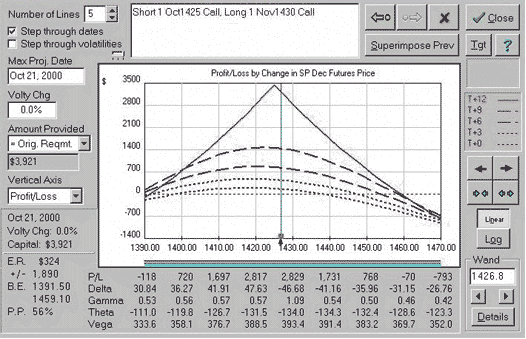
Oct 12
Bought 1 Oct SP 1410 call @ 500 (to close for 1700 point profit)
Sold 1 Nov SP 1400 call @ 620 (to open)
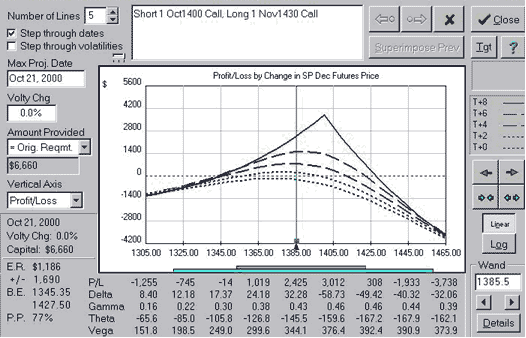
Oct 17
Bought 1 Oct SP 1400 call @ 400 (to close for 220 point profit)
Sold 1 Oct SP 1380 call @ 1050 (to open)
Bought 1 Oct SP 1380 call @ 600 (to close for 450 point profit)
Sold 1 Nov SP 1430 call @ 1160 (to close for 1990 point loss)
Over this 2-week period, these trades earned gain of 830 points ($2,075) on 7 call options. This favorable result occurred despite the fact that the Dec SP futures contract declined 5% from about 1427.00 to 1360.00 during that time. The positive result was a function of positive time decay, rising implied volatility, and "rolling" in the direction of the trend.
In Summary:
Diagonal Time Spreads when done in a systematic, consistent, and disciplined manner, can offer the following benefits:
-
Can earn positive option time decay.
-
Profit potential over a wide range of underlying futures prices.
-
Can be tailored to fit a bullish, bearish or neutral market outlook.
-
Can limit your risk on each trade as opposed to naked positions.
-
The position may be modified as market circumstances change.